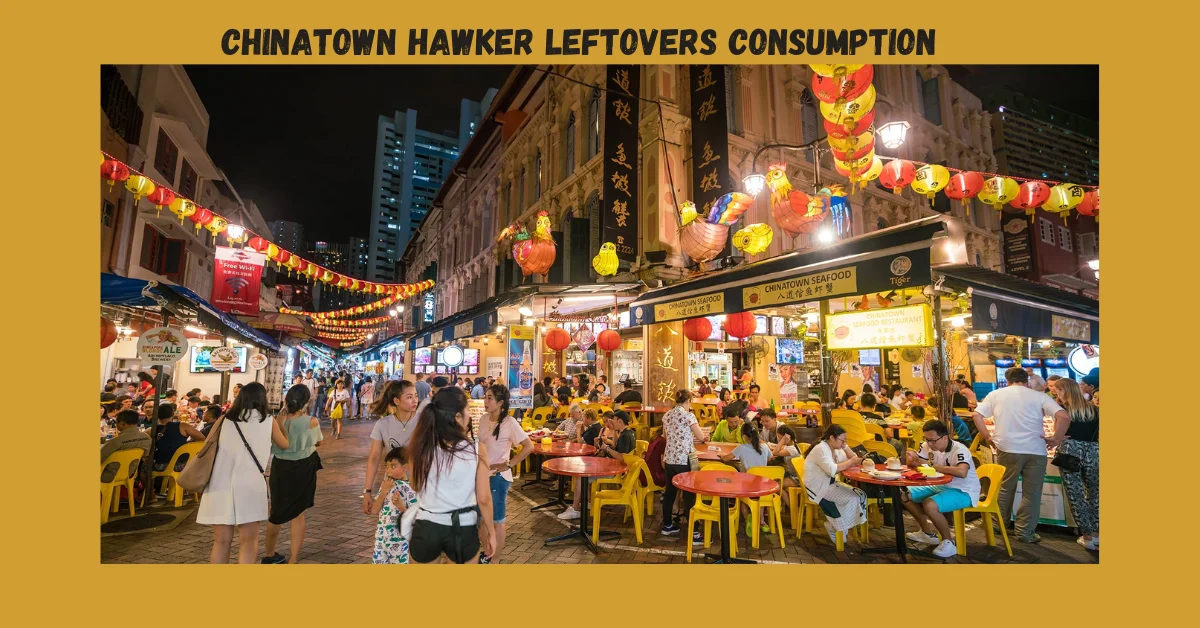Chinatown Hawker Leftovers Consumption: Maximizing Flavor and Safety After the Feast
Singapore’s Chinatown is renowned for its vibrant hawker centers, where various affordable and delectable street foods are served daily. These centers are not only culinary hotspots but also cultural landmarks that reflect the community’s rich heritage. However, beneath the bustling atmosphere lies a pressing issue: food waste. The consumption of hawker leftovers has emerged as a practice intertwined with cultural, economic, and environmental dimensions. This article delves into the multifaceted aspects of Chinatown hawker leftovers consumption, exploring its cultural significance, financial implications, health considerations, and sustainability impact.
The Cultural Significance of Chinatown Hawkers
The origins of Chinatown hawkers can be traced back to the initial wave of Chinese migration. The street vendors were the lifeline to newcomers by serving affordable, familiar food from other countries. As time passed, street hawker stands evolved into places of interest, renowned for their wide array of offerings including steaming bowls of dim sum to tasty noodle soups. In the present, they are an integral part of the Chinatown identity that draws both locals as well as visitors seeking authentic tastes.
Economic Implications of Leftover Consumption
Saving Money for Consumers
Many people in urban areas struggle with the rising cost of living, making discounted leftover food an attractive option. Budget-conscious individuals, students, and low-wage workers often rely on cheaper hawker meals to make ends meet.
Reducing Losses for Vendors
For hawkers, selling leftovers at reduced prices is a practical way to minimize financial losses. Instead of discarding food, vendors can still recover part of their costs. This can be particularly beneficial for small-scale hawkers who operate on thin profit margins.
The Rise of Food Rescue Startups
In some cities, businesses have emerged to tackle food waste by collecting unsold hawker food and redistributing it at lower prices through apps or community programs. These initiatives support vendors while making affordable meals accessible to a larger audience.
Why Do People Eat Hawker Leftovers?
There are several reasons why some individuals choose to consume leftovers from hawker centers:
Food Waste Awareness: Many people are increasingly aware of the massive food waste problem globally. Hawker stalls serve generous portions, and often, diners leave behind perfectly edible food.
Financial Constraints: For some, it’s a matter of necessity. The high cost of living in urban areas like Singapore makes it difficult for low-income individuals to afford meals.
Cultural Practices: In some cultures, finishing all food on a plate is a sign of respect, while others believe that discarded food can still be consumed if untouched.
Read Previous: Lyncconf mods
Best Practices for Consuming Hawker Leftovers
When indulging in Chinatown hawker leftovers consumption, a few guidelines will help you enjoy them safely and responsibly:
Check for Freshness
Even discounted food should look and smell appetizing. Avoid items that appear dried out, discoloured, or have an off odour. When in doubt, it’s better to pass.
Bring Your Containers
Some vendors might not have spare packaging for leftovers. Bringing your own containers ensures you can transport the food safely and reduces single-use plastics.
Reheat When Necessary
While many hawker leftovers are safe to eat, reheating them properly reduces the risk of foodborne illnesses. A quick zap in the microwave or a gentle simmer on the stove can make all the difference.
Enjoy Soon After Purchase
While leftovers are convenient, they’re not designed to last for days. Plan to eat them the same evening or the next day at the latest. Storing them correctly in the fridge and reheating them thoroughly will help maintain their quality.
Case Studies: Success Stories in Chinatown
The initiative was launched in the year 2018. The initiative works with more than 50 hawkers who collect unsold meals every day. Volunteers take leftover food to shelters, schools, senior centers, and other facilities and serve more than 10,000 meals per month. The success of the program is dependent on the trust of the community, efficient logistical processes, and strict adherence to standards for food safety.
The Environmental Impact of Food Waste
As the world grapples with the growing issue of food waste, understanding how leftovers fit into the broader environmental context is critical. According to the Food and Agriculture Organization (FAO), approximately one-third of all food produced worldwide is wasted, contributing to lost resources and increased greenhouse gas emissions.
Health and Safety Considerations
While the consumption of hawker leftovers addresses food waste issues and economic accessibility, it raises crucial health and safety concerns. Improper handling and storage of leftover food can lead to contamination and foodborne illnesses. To mitigate these risks, vendors and consumers must adhere to stringent food safety practices.
Government Policies and Support
The Singaporean government has recognized the need to address food waste and has implemented policies to support sustainable practices. The National Environment Agency (NEA) oversees waste management. It has introduced strategies focusing on preventing and reducing food wastage at the source, redistributing unsold or excess food, and treating food waste through methods like anaerobic digestion.
How You Can Support Leftovers Consumption
Be mindful when eating by choosing portions that you can finish, eating leftovers, and bringing them to take home. Join food rescue groups for helping to give away excess food items. Promote awareness by posting information on leftovers’ consumption through social media and within your circle of friends.
For Businesses
Join non-profit organizations to give unsold food items. Utilize sustainable methods by improving the management of inventory to reduce food waste.
For Policymakers
Incentivize donations by providing grants or tax deductions for businesses that participate in the process of food recovery. Build infrastructure through investment in cold storage facilities and transport equipment to help with the distribution of food.
FAQs
What are hawker stalls in Chinatown?
Hawker stalls in Chinatown are small, local food vendors offering a wide variety of inexpensive and delicious meals. These stalls are a popular choice for both locals and tourists looking to enjoy authentic, affordable cuisine.
Is it safe to consume leftovers from Chinatown hawker stalls?
As long as the food has been stored properly and consumed within a reasonable time frame, leftovers from Chinatown hawker stalls are generally safe to eat. It’s important to store them in airtight containers and refrigerate them promptly.
How long can hawker leftovers be stored?
Hawker leftovers should be stored in the refrigerator and consumed within 24 to 48 hours for the best taste and safety. Some dishes, like soups and stir-fries, may last longer, while others may lose their flavor quickly.
Can hawker food be reheated?
Yes, hawker food can be reheated, but it is important to reheat it thoroughly to ensure food safety. Using a microwave or stovetop is usually sufficient, but make sure the food is piping hot before consuming it.
Are there any specific foods from Chinatown hawker stalls that are better eaten fresh?
Some dishes, like fried items or foods with delicate textures (e.g., certain types of noodles or dumplings), may lose their crunch or freshness when stored as leftovers. It’s generally recommended to eat these dishes immediately for the best experience.
Conclusion
Leftovers from Chinatown hawker stalls can be a great way to enjoy delicious food again later, provided they are stored and reheated properly. While many dishes can retain their quality, some are best consumed fresh for the best taste and texture. Ensuring proper food safety practices will allow you to safely enjoy your favorite hawker meals even after the first serving.
Stay Connected With: Ventscrunch!

